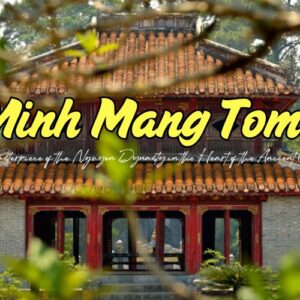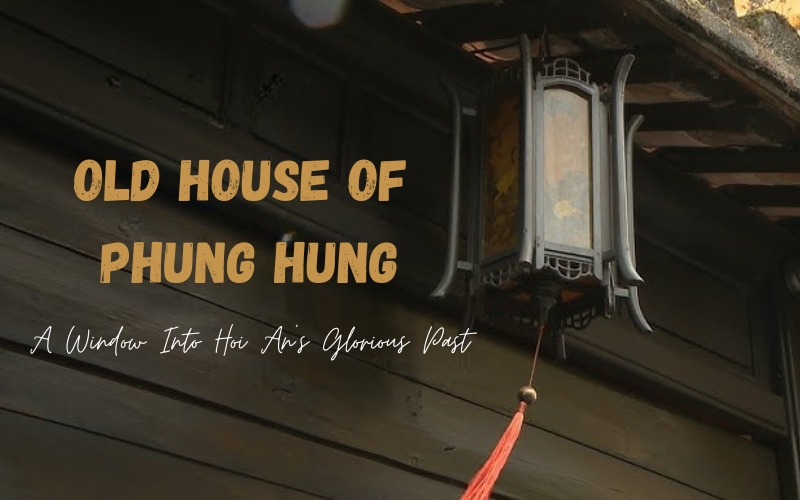
Old House of Phung Hung is an ideal destination for those who are passionate about exploring and learning about ancient cultures. Located inside the ancient streets of Hoi An, Old House of Phung Hung stands out as a striking mark of the past prosperous times in this splendid land. Up to now, this historic house is 442 years old, becoming a historical witness through many ups and downs in Hoi An. Take some time and join us to explore all the necessary information about this ancient house to make your journey more interesting.
General information of Old House of Phung Hung
Address: No. 4 Nguyen Thi Minh Khai Street, Hoi An City, Quang Nam Province
Opening hours: 8 AM – 6 PM
Entrance fee: 80,000 VND for Vietnamese visitors and 120,000 VND for international visitors, including 3 locations: Phung Hung Ancient House, Duc An Ancient House and Quan Thang Ancient House.
Old House of Phung Hung is a typical symbol of ancient architectural works during the period when Hoi An was a prosperous trading port. After 200 years of ups and downs of history, the ancient house still stands firmly and retains its original beauty. This ancient house is located next to the extremely famous Japanese Covered Bridge, making it easy for visitors to visit many famous places in Hoi An without having to travel too far.
Old House of Phung Hung was built around the end of the 18th century – early 19th century, about 200 years ago. Built during the most prosperous period of Hoi An, when coming here, visitors can admire the architectural quintessence of the last century. The design style has a strong Asian color with extremely unique details that will make many people immediately feel the hustle and bustle of an ancient Hoi An. On June 29, 1993, Old House of Phung Hung was honored to be certified as a National Historical-Cultural Relic.

The Old House of Phung Hung
History of Old House of Phung Hung
Old House of Phung Hung was built around the end of the 18th century by a Vietnamese merchant with the purpose of trading in high-end items such as cinnamon, pepper, salt, silk, ceramics, and glass. The name “Phung Hung” was given by the homeowner with the meaning of “prosperity” with the wish for smooth and prosperous business. Up to now, the house is still being lived in and preserved by the 8th generation descendants. Currently, the house serves as a garment and hand embroidery production facility for the family, visitors can buy beautiful souvenirs.
> > > Visiting the Old House of Phung Hung is just one of the many ways to immerse yourself in Hoi An’s rich history. Let’s join our guided Hoi An tours to uncover even more cultural treasures, charming streets, and hidden gems that make this ancient town unforgettable.
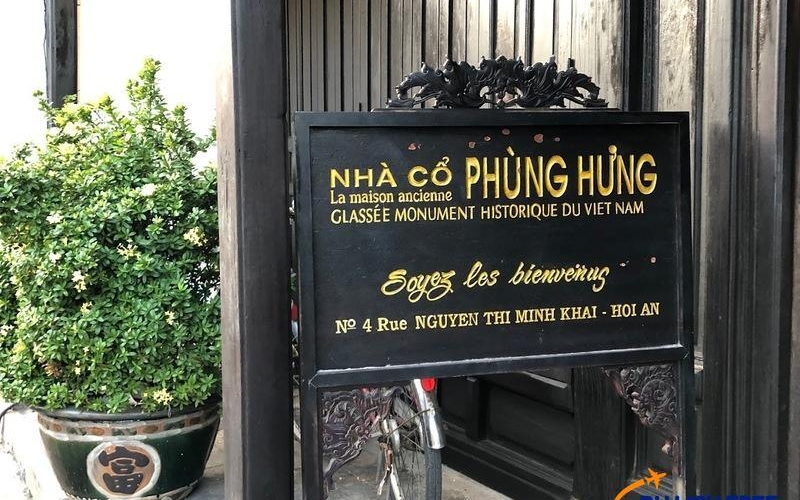
Visitors will see the nameplate of the house right at the entrance, symbolizing a wish for prosperity
Explore the architecture of the old house
Overview of the ancient house
The Old House of Phung Hung is greatly influenced by the styles of Chinese, Japanese and Vietnamese cultures. From the outside, the house has a tube shape, a wide facade, clearly showing the owner’s desire and aspiration for “prosperity and prosperity”. The house is 2 stories high with 2 connecting ridges facing the Northwest and has up to 4 roofs, very suitable and convenient for business and trade in ancient times.
Above the main door are 2 door eyes (Than Mon), an architectural mark in Hoi An Ancient Town. The door eyes are often used for decoration and carry important spiritual elements, the door eyes are considered to be the guardians of the house, avoiding bad things that want to invade. The house is made entirely of ironwood and other rare woods, thanks to which, to this day, it still retains its original color and shape. The house uses wood as the main material for the frame, structural floor, yin-yang tiled roof, brick walls with many elaborate carvings on columns, wooden beams, and girders.
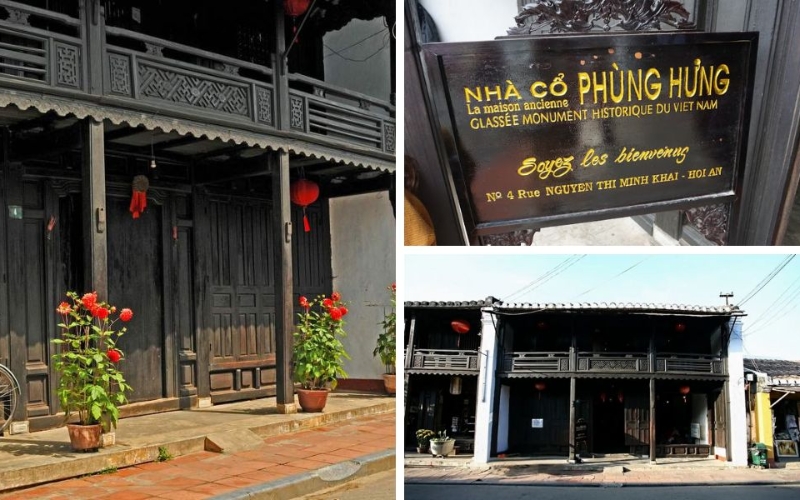
The house is primarily made of ironwood, giving it a sturdy appearance that endures over time
The ground floor
The ground floor used to be the first owner’s place to display and sell goods, and is now the area to store the previous owner’s antiques and to receive guests. Visitors can sit and relax on a set of exquisite mother-of-pearl inlaid tables and chairs made of luxurious ironwood placed in the middle of the house. The table and chairs are not only a place to receive guests but also a symbol of the wealth and refined aesthetic taste of the merchant family. The walls around the ground floor are decorated with delicate and artistic carvings created by the artisans of Kim Bong carpentry village.
Entering the inner room, visitors will immediately see a horizontal lacquered board with the four characters “The Duc Luu Quang” hanging on the door, meaning that the virtues of ancestors are passed down and shine, and there are also meaningful pairs of antithetical pairs on both sides of the door. The entire ancient house has 80 extremely sturdy ironwood columns, all of which are placed on stone pedestals to avoid damage.
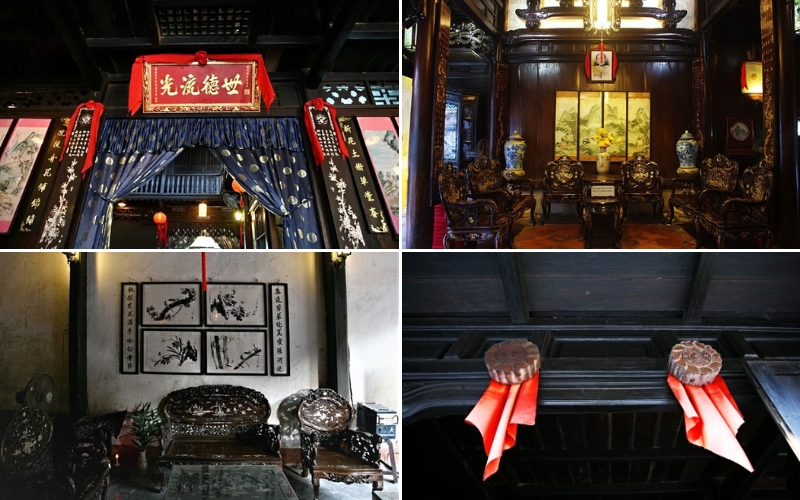
The first floor used to be a trading area and is now the main reception area of the house
When you get to the inner room, you will immediately see the living room, above is a high open space that reaches the roof to help the house be more airy. Looking up to the second floor, you will see a surrounding railing, the roof above the open space has the Tu Hai roof architecture spreading out in all directions, bearing the mark of Japanese architecture. The innermost room is where the family lives and has a staircase to the second floor.
The second floor
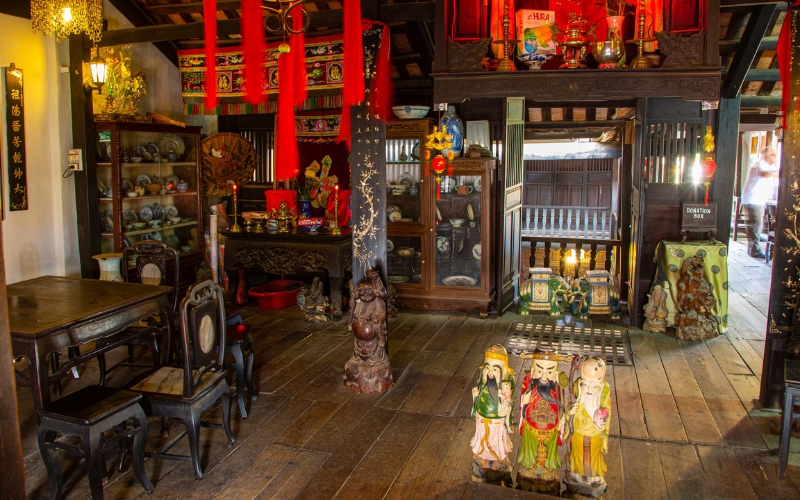
The worship area on the second floor of the Old House of Phung Hung
Stepping up to the second floor of the house, visitors will feel a sacred and ancient feeling covering the whole room. This is the main place of worship of the house, with an altar for ancestors and Jade Emperor, a deity according to Chinese beliefs. There is a table placed in front of the altar, where the homeowner will put 7 marble dice in a bowl, and when traveling far, they will roll the dice to decide the departure time.
In particular, because it is located near the river, in the past, floods often occurred, so the attic floor has square gaps, called “trap doors”. This door has the function of connecting to the lower floor, used to move goods to the upper floor in case of flood.
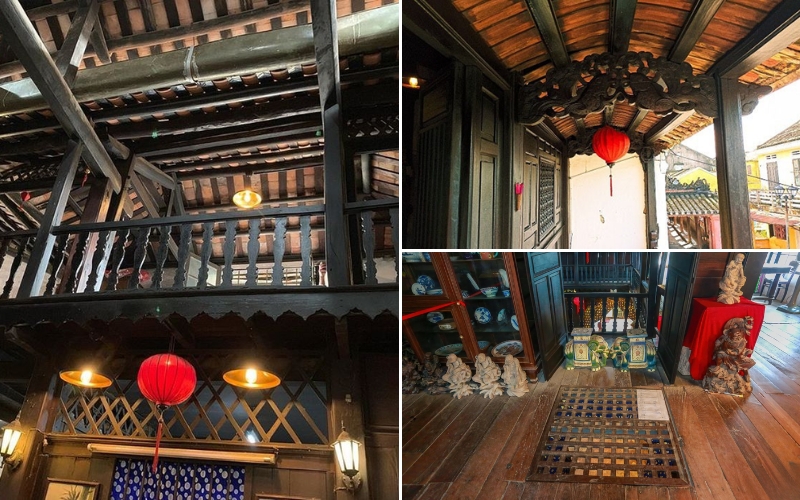
The unique roof structure and trapdoor design on the second floor
The front porch of the second floor is designed in Chinese architectural style with a crab shell ceiling, a carp-shaped support frame, a symbol of luck, prosperity, and power in the cultures of the three countries of Vietnam, China, and Japan. In addition, Phung Hung ancient house still preserves many antiques dating back hundreds of years, such as household items, altar cabinets, horizontal lacquered boards, and ancient transaction documents,….
Other attractions near Old House of Phung Hung
Besides Old House of Phung Hung, Hoi An still has many other interesting places to visit that you can incorporate into your itinerary. Check out some other interesting addresses in Hoi An:
- Hoi An night market: This is an ideal place to have fun and experience authentic Hoi An cuisine. Don’t forget to buy more gifts for relatives and friends. The night market opens from 5 pm to 11 pm every day, very suitable for a relaxing evening walking around town!
- Japanese Covered Bridge: Located next to Old House of Phung Hung, it is a bold Japanese – Vietnamese – Chinese style with extremely unique architecture. It is also a symbol of Hoi An ancient town with its outstanding appearance
- Phuc Kien Assembly Hall: Built in the 16th century, this is a typical cultural architectural work with many meanings and historical marks associated with many generations in Hoi An. This hall possesses magnificent architecture, delicate carvings, splendid splendor with the main red color that stands out in the whole area.
- Sa Huynh Cultural Museum: A place to display and preserve thousands of artifacts about ancient residents of the Sa Huynh Cultural system. This will be a suitable place for tourists who are interested in learning about Sa Huynh culture.
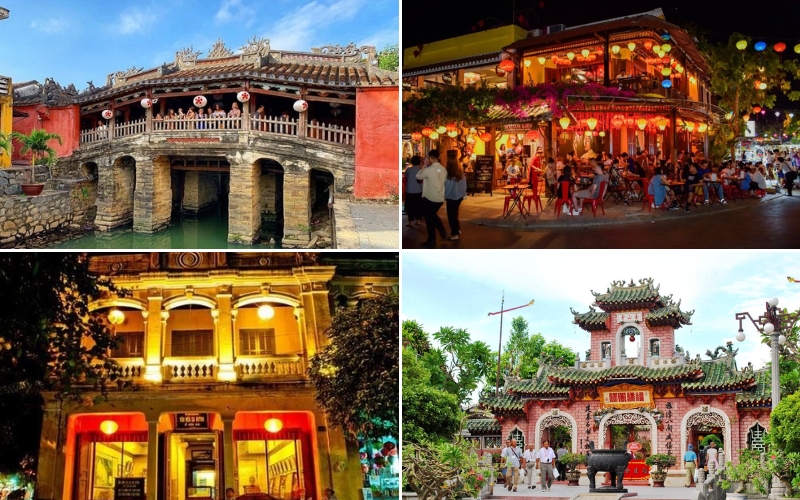
Some famous attractions near the old house
Some helpful tips for your first trip to the old house
Although it is a famous tourist attraction, Old House of Phung Hung is also a national monument. Therefore, when coming here, please note the following:
- You should choose the right time, avoid holidays and Tet to avoid crowds and reduce the sightseeing experience. You can come early in the morning when the door just opens so you can freely explore and enjoy the peaceful atmosphere.
- When visiting the ancient house, avoid direct contact with the artifacts and do not enter the private area without permission because the owner is still living here.
- Because Old House of Phung Hung is located in Hoi An, you should arrange your schedule to be the most reasonable. You can also consider hiring a local guide to better understand the history and architectural significance of the house, enriching your tour.
- The ground floor of the house is where local handicrafts and traditional products are sold, you can buy these items to support the preservation of traditional crafts and local communities.
If you want to learn about a brilliant Hoi An in ancient times, Old House of Phung Hung is definitely an ideal destination! You will feel like you are immersing yourself in the trading space, busy with ancient merchants, experiencing the life, spiritual life and soul of the people in the old town. If you have the opportunity to visit Hoi An, remember to add Old House of Phung Hung to your list of places to visit!
Read more:



